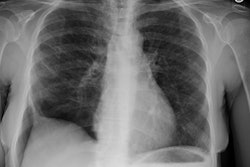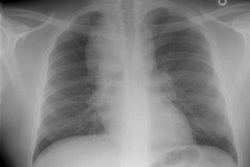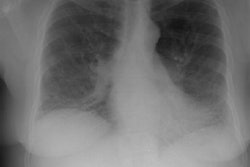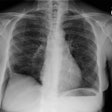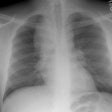Goodpasteur's Syndrome:
View cases of Goodpasteur's syndrome
Clinical:
Goodpasteur's syndrome results from the presence of an IgG anti-glomerular/ alveolar basement membrane antibodies (detected by radioimmunoassay in over 90% of cases). It represents a Type II immune reaction (cytotoxic antibody mediated). Males are affected more than females (9:1) and the disorder is associated with HLA DRW2. The majority of patients present in their mid-twenties with hemoptysis (75%- due to diffuse pulmonary hemorrhage [DAH]), hematuria (due to glomerulonephritis), anemia, hepatosplenomegaly, and hypertension. Pulmonary symptoms will generally proceed the renal disease by weeks to months, although many patients also have laboratory evidence of renal disease at the time of presentation (microscopic hematuria). Treatment consists of high dose corticosteroids and plasmapheresis to remove the anti-glomerular basement membrane antibody. Cytotoxic chemotherapy is used in severe cases of the disorder. Prognosis is poor, usually secondary to renal failure, but remissions in renal and pulmonary disease can occur if treatment is instituted early.X-ray:
CXR: On CXR there are classically patchy parenchymal consolidations which are usually bilateral, symmetric perihilar and bibasilar. The apices and costophrenic angles are usually spared. The consolidation resolves over 2 to 3 days and gradually progresses to an interstitial pattern as they experience repeated episodes of hemorrhage. Up to 18% of patients may have a normal radiograph despite extensive pulmonary hemorrhage. Hilar adenopathy may be seen during acute episodes.REFERENCES:
(1) AJR 1995 Feb;164(2):295-300
(2) Radiol Clin North Am 1991 Sep;29(5):965-971
(3) Radiology 2010; Chung MO, et al. Imaging of pulmonary vasculitis. 255: 322-341

